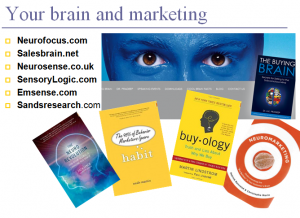 If you want to know more about how to write content that makes an impact on the brains of your readers, here are some interesting sites and books about the emerging field of neuromarketing.
If you want to know more about how to write content that makes an impact on the brains of your readers, here are some interesting sites and books about the emerging field of neuromarketing.
There are new neuromarketing companies and books galore, and I believe most offer important clues for content marketers. Here are a few of my favorites:
- Neurofocus.com: The Neurofocus CEO, A.K. Pradeep, has authored a book, The Buying Brain –Secrets for Selling to the Subconscious Mind. I loved this book for it’s ability to translate brain scan results with a marketing perspective in layman’s terms. However, much of it seems to promote the services of their company. Well, of course it would. The site set up especially for The Buying Brain book has a page of “cool brain facts,” that are fun to read.
- Salesbrain.net: Founders of this company, Patrick Renoise and Christophe Morin, are also authors of Neuromarketing: Understanding the Buy Buttons in Customers’ Brains. They also founded an excellent social networking site, Neuromarketing.com, a Ning group, for people interested in how brain science can be applied to marketing. Read More→










